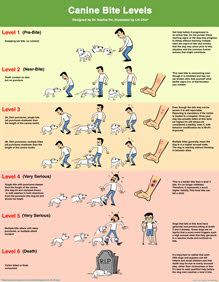Christine Calder, DVM, DACVB; Originally written by Sophia Yin, DVM, CAAB, MS Animal Science (1966-2014)
One way to find out how serious a bite may be is to acknowledge that different levels of bites exist. Bite levels range from minor to so severe they lead to death. Dr. Ian Dunbar first developed this bite levels system and Dr. Sophia Yin created a modified description of the levels.
Canine Bite Levels Poster

Photo Courtesy of CattleDog Publishing
Click to enlarge.
Level 1 (pre-bite)
The dog snaps or air bites but makes no contact with the person. People tend to say, “The dog tried to bite me but I moved away.” Humans have slow reactions compared to the speed of a biting dog and dogs have good aim when trying to grab things. If the dog actually meant to bite rather than warn, it would have succeeded. This air snap indicates there were earlier signs of the dog's displeasure or fear. Owners should get help before this pre-bite behavior progresses to an actual bite. Avoid punishing warning signs or the dog may progress to biting without warning. Instead, learn the signs of fear and anxiety that the dog probably showed prior to this situation and learn to spot the common inappropriate human actions that may have contributed to the snap.
Level 2 (near-bite or highly inhibited bite)
The dog snaps and makes tooth contact on skin but there’s no actual puncture. Often the dog runs up to or lunges for a person but just puts front teeth in contact with the skin in a sort of near-bite. In other cases, the dog actually opens his mouth and clamps but in an inhibited manner such that no skin is broken. Again the owners should ask, “What earlier signs did we miss to warn us that this could happen?” The owners should realize, the near-bite or inhibited bite could turn into a real bite down the road.
Level 3A
The dog bites once and punctures skin, but the puncture is shallower than the length of the canine tooth. Even though this bite may not be severe, it is still reportable. And painful, too. Reporting is mandatory if the victim is treated in a hospital. Once your dog has actually bitten at this level (or higher) he will always be considered a liability, even if, with behavior modification, he is 99.9% improved.
Level 3B
The dog bites multiple times leaving skin punctures shallower than half of the canine. Multiple bites generally mean the dog is in a higher arousal state. That is, the dog is reacting without thinking between bites.
Level 4
The dog bites once with punctures deeper than the length of the canine (the dog bit and clamped down) or the bite produces slashes in both directions from the puncture which indicates that the dog bit and shook his head. This type of bite is very serious. While any of the lower bite levels should act as warning signs telling the owners to seek help from a qualified and educated behavioral modification specialist, the level 4 bite indicates this has been building up and you should have gotten help long ago. Level 4 bites are much harder than level 3 bites and show no inhibition in strength. A dog biting at this level presents a liability to the owners, both in terms of money and family members because this type of bite can kill a child.
Level 5
The dog gives multiple bites with deep punctures. Dogs who bite at this level generally have had practice biting at levels 3 and 4. Some dogs are so fearful that a scary event triggers a high arousal state and they get stuck in a reactive mode, continuing to bite hard.
Level 6
The dog kills the victim or consumes their flesh. It’s important to realize that even little dogs and puppies can bite hard enough to kill infants and small children. Dogs can bite this hard due to fear, but they can also bite and cause death due to over aroused play.
What Should You Do If Your Dog Bites?
Now that you know dogs can bite at different levels and early snapping and low-level bites can, and often do, lead to more severe bites, you can start addressing the biting as soon as you see any low-level warning signs.